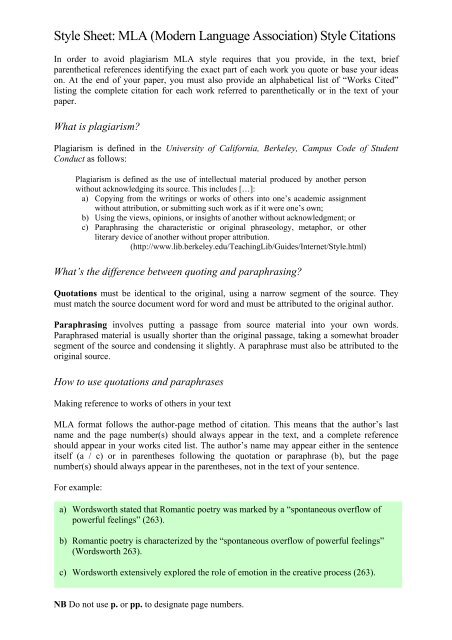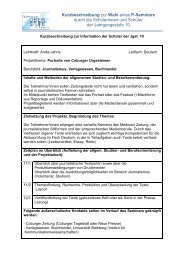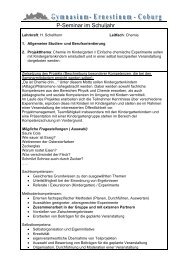Style Sheet: MLA (Modern Language Association) Style Citations
Style Sheet: MLA (Modern Language Association) Style Citations
Style Sheet: MLA (Modern Language Association) Style Citations
Create successful ePaper yourself
Turn your PDF publications into a flip-book with our unique Google optimized e-Paper software.
<strong>Style</strong> <strong>Sheet</strong>: <strong>MLA</strong> (<strong>Modern</strong> <strong>Language</strong> <strong>Association</strong>) <strong>Style</strong> <strong>Citations</strong><br />
In order to avoid plagiarism <strong>MLA</strong> style requires that you provide, in the text, brief<br />
parenthetical references identifying the exact part of each work you quote or base your ideas<br />
on. At the end of your paper, you must also provide an alphabetical list of “Works Cited”<br />
listing the complete citation for each work referred to parenthetically or in the text of your<br />
paper.<br />
What is plagiarism?<br />
Plagiarism is defined in the University of California, Berkeley, Campus Code of Student<br />
Conduct as follows:<br />
Plagiarism is defined as the use of intellectual material produced by another person<br />
without acknowledging its source. This includes […]:<br />
a) Copying from the writings or works of others into one’s academic assignment<br />
without attribution, or submitting such work as if it were one’s own;<br />
b) Using the views, opinions, or insights of another without acknowledgment; or<br />
c) Paraphrasing the characteristic or original phraseology, metaphor, or other<br />
literary device of another without proper attribution.<br />
(http://www.lib.berkeley.edu/TeachingLib/Guides/Internet/<strong>Style</strong>.html)<br />
What’s the difference between quoting and paraphrasing?<br />
Quotations must be identical to the original, using a narrow segment of the source. They<br />
must match the source document word for word and must be attributed to the original author.<br />
Paraphrasing involves putting a passage from source material into your own words.<br />
Paraphrased material is usually shorter than the original passage, taking a somewhat broader<br />
segment of the source and condensing it slightly. A paraphrase must also be attributed to the<br />
original source.<br />
How to use quotations and paraphrases<br />
Making reference to works of others in your text<br />
<strong>MLA</strong> format follows the author-page method of citation. This means that the author’s last<br />
name and the page number(s) should always appear in the text, and a complete reference<br />
should appear in your works cited list. The author’s name may appear either in the sentence<br />
itself (a / c) or in parentheses following the quotation or paraphrase (b), but the page<br />
number(s) should always appear in the parentheses, not in the text of your sentence.<br />
For example:<br />
a) Wordsworth stated that Romantic poetry was marked by a “spontaneous overflow of<br />
powerful feelings” (263).<br />
b) Romantic poetry is characterized by the “spontaneous overflow of powerful feelings”<br />
(Wordsworth 263).<br />
c) Wordsworth extensively explored the role of emotion in the creative process (263).<br />
NB Do not use p. or pp. to designate page numbers.
2<br />
If the work you are making reference to has no author, use an abbreviated version of the<br />
work’s title. For non-print sources, such as films, TV series, pictures, or other media, or<br />
electronic sources, include the name that begins the entry in the Works Cited page. For<br />
example:<br />
The UC Berkeley Campus Code of Student Conduct defines plagiarism as “the use of<br />
intellectual material produced by another person without acknowledging its source” (<strong>Style</strong><br />
<strong>Sheet</strong>s for Citing Resources).<br />
Sometimes you may have to use indirect quotation. An indirect quotation is a quotation that<br />
you found in another source that was quoting from the original. For such indirect quotations,<br />
use “qtd. in” to indicate the source. For example:<br />
Miller himself said that “the story of Salesman is absurdly simple! It is about a salesman<br />
and it’s his last day on the earth” (qtd. in Bigsby 104).<br />
For works with more than two authors or editors use first author’s name and “et al.” (Latin: et<br />
alii = and others).<br />
Quotations<br />
To indicate short quotations (fewer than four typed lines of prose or three lines of verse) in<br />
your text, enclose the quotation within double quotation marks and incorporate it into your<br />
text. Punctuation marks such as periods, commas, and semicolons should appear after the<br />
parenthetical citation. Questions marks and exclamations marks should appear within the<br />
quotation marks if they are a part of the quoted passage (then you still need a period after the<br />
parenthetical citation!) but after the parenthetical citation if they are a part of your text.<br />
“Incorporating” short quotations into your text means that you must be careful that the<br />
grammatical forms and the sentence structure are correct. Therefore, it is sometimes necessary<br />
to add or omit words or even change forms. All these changes must be indicated by using<br />
brackets and ellipsis marks. For example:<br />
Harold Bloom argues that “His [i. e. Graham Greene’s] more celebrated novels fade already<br />
into the continuum of literary tradition” (8).<br />
-> The additional information is given in square brackets.<br />
-> A capital letter (His) is used with the first word of a direct quotation of a whole sentence.<br />
-> Do not use a capital letter with the first word of a direct quotation of part of a sentence.<br />
According to Lawrence we are all relieved that not everybody is as deluded as Willy “When<br />
Biff says […] that his father ‘had the wrong dreams’” (57).<br />
-> If you omit a word or words from a quotation you must indicate the deleted word(s) by<br />
using ellipsis marks surrounded by square brackets.<br />
-> For a quotation within a quotation you should use single quotation marks.<br />
When Joachim tells Hans Castorp that Behrens is annoyed by patients who aren’t willing to<br />
die, Hans Castorp says, “Daß [sic] geht nicht, daß man ihn so mir nichts, dir nichts –”, but<br />
he can’t finish the sentence because he bursts out laughing (Mann 80).<br />
-> Use [sic] (Latin = “so”, “thus”) to indicate that a mistake is in the source you are quoting<br />
and not your own.
3<br />
If you quote poetry and you integrate the lines into your text, a slash (/) with a space on either<br />
side is used to separate lines. For example:<br />
In Julius Caesar, Antony begins his famous speech with “Friends, Romans, Countrymen,<br />
lend me your ears; / I come to bury Caesar, not to praise him” (III.ii.75-76).<br />
Long quotations (longer than four typed lines of prose and three typed lines of verse) are<br />
placed in a free-standing block. Quotation marks are omitted. Start the quotation on a new<br />
line, indented one inch (2.54 cm) from the left margin. Your parenthetical citation should<br />
come after the closing punctuation mark. For example:<br />
In his essay “The Right Dream in Miller’s Death of a Salesman”, Lawrence concludes that<br />
Willy’s dreams may not be so wrong after all.<br />
The Works Cited List<br />
Basic rules:<br />
Willy may be deluded but his only delusion is that he thinks men can<br />
be magnificent because they love. This is not the error of a petty man.<br />
Willy is a dreamer. But part of the dream is good. […] Attention must<br />
be paid to Willy Loman because he believes in love, which is only the<br />
extreme form of being well liked. (59)<br />
- Authors’ names are inverted (last name first); if a work has more than one author, invert<br />
only the first author’s name, follow it with a comma, then continue listing the rest of the<br />
authors.<br />
- If you have cited more than one work by the same author, order them alphabetically by<br />
title, and use three hyphens in place of the author’s name.<br />
- If no author is given for a particular work, alphabetize by the title of the piece and use a<br />
shortened version of the title for parenthetical citation.<br />
- Capitalize each word in the titles of articles, books, etc. This rule does not apply to<br />
articles, short prepositions, or conjunctions unless one is the first word of the title or<br />
subtitle.<br />
- Underline or italicize titles of books, journals, magazines, newspapers, and films.<br />
BOOKS<br />
General Format Author#1LastName, FirstName(s), and Author#2FirstName(s) Last Name.<br />
Title of Book. Place of Publication: Publisher, Date of Publication.<br />
Single author Bigsby, Christopher. Arthur Miller: A Critical Study. Cambridge: Cambridge<br />
University Press, 2005.<br />
Multiple authors Booth, Wayne C., Gregory G. Colomb, and Joseph M. Williams. The Craft of<br />
Research. 2nd ed. Chicago: U of Chicago P, 2003.<br />
For works by more than three authors or editors, you may list all as above or<br />
only the first followed by a comma and “et al.”<br />
Translated Work Racine, Jean. Jean Racine’s Phaedra: A Tragedy: A New Verse Translation of<br />
Phèdre. Trans. Edwin Morgan. Manchester, Eng.: Carcanet, 2000.<br />
Multi-volume work Dostoyesvky, Fyodor. The Unpublished Dostoyesky: Diaries and Notebooks<br />
(1860-81). Ed. Carl R. Proffer. Trans. T. S. Berczynski, et al. 3 vols. Ann<br />
Arbor: Ardis, 1973-1976.<br />
No author named The Bible with Sources Revealed: A New View into the Five Books of Moses.<br />
1st ed. Trans. and commentary Richard Elliot Friedmann. San Francisco:<br />
Harper, 2003.
4<br />
CHAPTER IN A BOOK or WORK IN AN ANTHOLOGY or COLLECTION<br />
General Format AuthorLastName, FirstName(s). “Title of Book Chapter or Work in Other<br />
Collection.” Title of Book, Anthology, or Collection. Place of Publication:<br />
Publisher, Date of Publication. Page Numbers.<br />
Chapter in a book Johnson, D. Barton. “Nabokov and the Sixties.” Discourse and Ideology in<br />
Nabokov’s Prose. Ed. David H. J. Larmour. London: Routledge, 2002.<br />
139-49.<br />
Work in anthology Allende, Isabel. “Toad’s Mouth.” Trans. Margaret Sayers Peden. A Hammock<br />
beneath the Mangoes: Stories from Latin America. Ed. Thomas Colchie.<br />
New York: Plume, 1992. 83-88.<br />
MAGAZINE ARTICLES<br />
General Format Author’sLastName, FirstName(s). “Title of Article.” Title of Magazine Day<br />
Month Year of Publication: page numbers.<br />
No author named “The Decade of the Spy.” Newsweek 7 Mar. 1994: 26-27.<br />
Author named Heiling, Jean M. “E-Global Library: The Academic Campus Library Meets<br />
the Internet.” Searcher June 2001: 34-42.<br />
NEWSPAPER ARTICLES<br />
General Format Author’sLastName, FirstName(s). “Title of Article.” Title of Newspaper [City<br />
of Publication if not in Title] Day Month Year of Publication, edition: page<br />
numbers.<br />
Fabricant, Florence. “From Italy, A New Culinary Movement Offers a Wry<br />
Answer to Fast Food.” New York Times 15 Nov. 1989, national ed.: B6-7.<br />
A WEBSITE or WEB PAGE WITHIN A WEBSITE<br />
General Format AuthorLastName, FirstName(s). “Title: Subtitle of Part of Web Page, if<br />
appropriate.” Title. Subtitle of Page. Publishing Agency, If Given. Date of<br />
Electronic Publication or other Date, such as Last Updated. Day Month<br />
Published by an<br />
academic institution<br />
Year of access .<br />
A Glossary of Rhetorical Terms with Examples. Div. of Classics, Dept. of<br />
<strong>Modern</strong> & Classical <strong>Language</strong>s, Literatures, & Cultures, U of Kentucky. 1<br />
Apr. 2004 .<br />
For more information cf. UC Berkeley Library at<br />
http://www.lib.berkeley.edu/TeachingLib/Guides/Internet/<strong>Style</strong>.html.

















